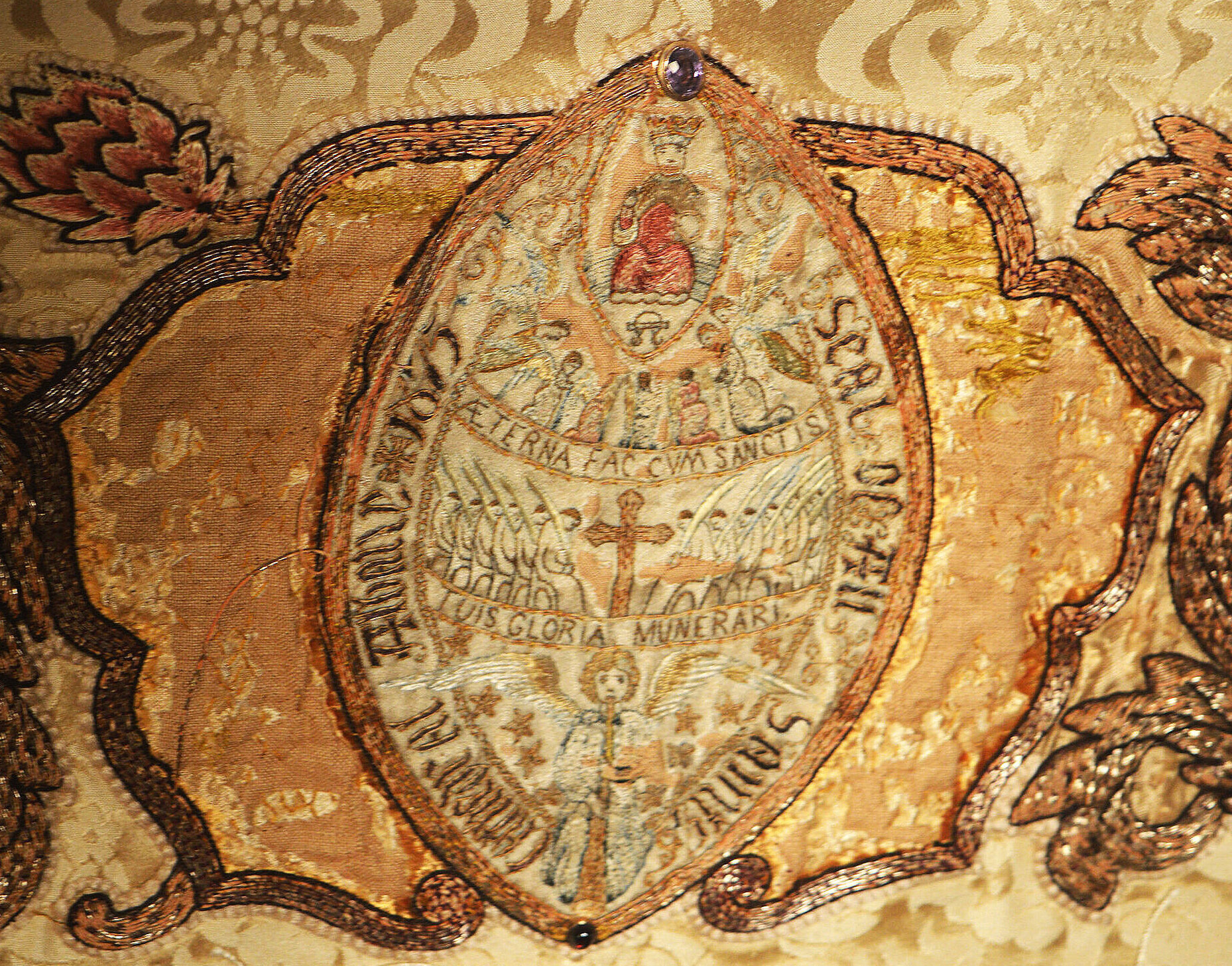Textile Art & Artisans — Yesterday
The Red Frontal
The embroidered figures on this altar frontal are European, Flemish in appearance and thought to be from the fifteenth century. They appear on the Cathedral’s “red frontal” and are shown here courtesy of the Cathedral’s Altar Guild—traditionally a group of women, but today a fellowship that also includes men whose care in maintaining liturgical textiles beautifies worship and preserves history.
Visit our Textile Art-Today page to see recent projects of the artisans of the Cathedral’s Altar Guild and vestments and cushions that are part of our daily Anglo-Catholic style of traditional worship. Please consider making a donation to support this work of beauty and cultural preservation below.
At the top of this figure (likely St. Paul who is often depicted holding a book and a sword—the “sword of the spirit”), is seen lace thought to have belonged to Marie Antoinette. Read below for more of the history of the Red Frontal in a piece written by artist, designer and Cathedral member James Gwynn (1921-2015) for the Swan and Elk newsletter in Lent of 2012:
The Story of The Corning Lace, by James Gwynn
Spawned by the deep theological discussions of the Oxford Movement, the Cambridge Camden Society began to advocate for beauty in churches, especially the architectural and ceremonial aspects of worship. This return to the medieval ceremonies, rituals and trappings of the early church sent a frisson through the Low Church crowd and in many cases divided congregations. In Albany, while Bishop Doane through his lone episcopacy never wore a cope, mitre or Eucharistic vestments, he did embrace much of the Oxford Movement. However, textiles began to accumulate in sacristies, and, realizing that some provision had to be made for their general care, around about 1890 he asked for volunteers to form an embroiders' guild whose charge was to be the general maintenance and repair of such items, and in some cases, the making of new ones.
Many women responded to the call including social luminaries such as Mrs. Theodore Roosevelt and her sister, Miss Carew; Mrs. William Gorham Rice, daughter of Mrs. H.V.L. Pruyn; Catherine Brinkerhoff Evans; and others of the BonTon. They took up quarters in a house on Lafayette St. which in those days ran from Hawk St. to Swan following the path of the present alley between the Cathedral and the State Education building. With the completion of Oscar Hasey's Guild House they moved there, and with many changes in make up the guild lasted until the 1940's when it was disbanded.
Among the many treasures handed down to us by the Guild is a claret-colored velvet High Altar frontal incorporating panels of 15th century Italian embroidery and a super-frontal of beautiful rose point lace. The story of that lace is intriguing. It was reputedly part of the personal effects of Marie Antoinette, was bought at auction in Paris by Erastus Corning, and was to be used as trimming on a gown for Mrs. Corning to wear to Abraham Lincoln's inaugural Ball. The lace was sent to a dress maker in New York City where it disappeared.
Pinkerton Men were hired to trace it and it was found cut in three lengths, in a shop in that city. Whether or not Mrs. Corning twirled around the dance floor in the gown is not-recorded, but if she did, it was without the lace, which was discovered too late to use. Guild records tell us that Mrs. A. Palmer made the super-frontal for use on the High Altar.
The Corning Frontal
This white altar frontal is known as the “Corning Frontal” because it is a believed to be a gift from the Corning family who made many gifts—including the land on which The Cathedral of All Saints is built.
It contains great variety in its embroidery and appliqué—-both in style and execution, and is thought to have, in part, been a project of the young women who attended St. Agnes School which Bishop William Croswell Doane built when he built the Cathedral. Note how lines of ink show where thread has worn away revealing the careful drawings—perhaps by the school’s best artists.
Note also the cloth between the figures that was replaced in 1988. It is not unusual for textile used in worship to be removed from its original location and repurposed for another use as in the story above of the lace in the red frontal. Read another history below, centered around this white frontal known as “The Corning Frontal.”
History of the Cathedral Embroiderers Guild and the Corning Frontal
The first Cathedral Embroiderers Guild was formed circa 1890 and originally met in a dwelling just below the present Guild House on Lafayette St., eventually making their permanent home in the Guild House. The Guild did a great deal of work, making various articles for the Cathedral and the parishes of the Albany Diocese, until they became the victims of cost-cutting in 1916. Original members of the Guild included Mrs. Theodore Roosevelt and her sister. In 1921, the Vestment Committee was formed by members of the Cathedral Altar Guild, with the objective to keep the Cathedral vestments in good repair and replace them as needed. The committee was disbanded in the 1930's.
A 1929 newspaper article about the Cathedral Vestment Committee describes "a white brocade frontal embroidered in gold and studded with gems" that could be a reference to the Corning Frontal. There are no known records of when the frontal was made and by whom, its early history or how it came to be associated with the Corning family.












